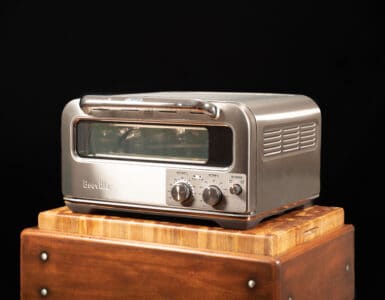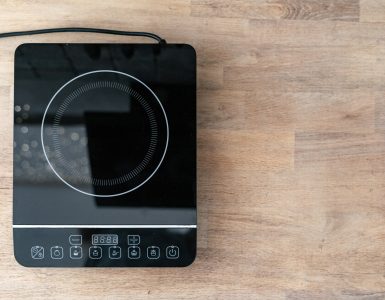This page may contain affiliate links. If you make a purchase through one of these links, we may earn a commission at no extra cost to you.

Here at Cuisine Technology, writers are supposed to do their best to go into reviews like this with an open and unbiased mind. In this case, I failed at that: I really, really wanted to love Stasher bags, so I was really excited to do this hands-on review.
After all, Stasher bags check all the boxes: they’re reusable, plastic-free, and women-owned. (And they’re even designed by a company based just a couple miles from my beloved hometown by a woman who graduated from my alma mater! Go Bay Area!) Finally, I thought, I’d found the solution to the dilemma of single-use plastic in sous vide cooking.
Sadly, I was wrong. Because while these bags check so many important boxes, they miss enough others that they’re not the ultimate solution that I had hoped. In fact, after my experience using these bags for this hands-on review, I don’t recommend them for sous vide at all. Read our complete hands-on Stasher bags review to learn why I unfortunately don’t think they’re worth the money (at least, not if you’re planning to sous vide in them).
Table of Contents
Quick Summary/Overview
The premise of these bags is simple yet powerful: an (almost) endlessly reusable silicone bag that works for everything from picnics to freezing food to sous vide. I appreciate that they’re truly plastic-free, even in the packaging. And the concept sounds fantastic; it would be such a joy to be able to eliminate single-use plastic bags both for storage and sous vide.
This review will focus on using Stasher bags for sous vide specifically. Some of these experiences may apply to other uses as well, but my focus is definitely on how they function for sous vide cooking. As a result, I haven’t tested these bags for freezer storage, microwave reheating, etc.
First Impressions
Stasher bags create a fantastic first impression. They come in a range of colors that suit any taste, style, or kitchen. The packaging is simple, straightforward, and attractive, creating an initial impression of quality and definitely fitting in with their eco-friendly mission.
The bags themselves are more supple than I would have expected before touching them, and feel high quality. Once you have one in your hands, it makes sense that these bags are supposed to be able to last for up to 3,000 uses.
However, it’s also immediately clear why some people have complained about struggling to clean these bags. The stiff grooves that allow the bag to close securely are deep, and the corners are tight. There are plenty of places for food to get stuck that seem almost impossible to thoroughly clean.
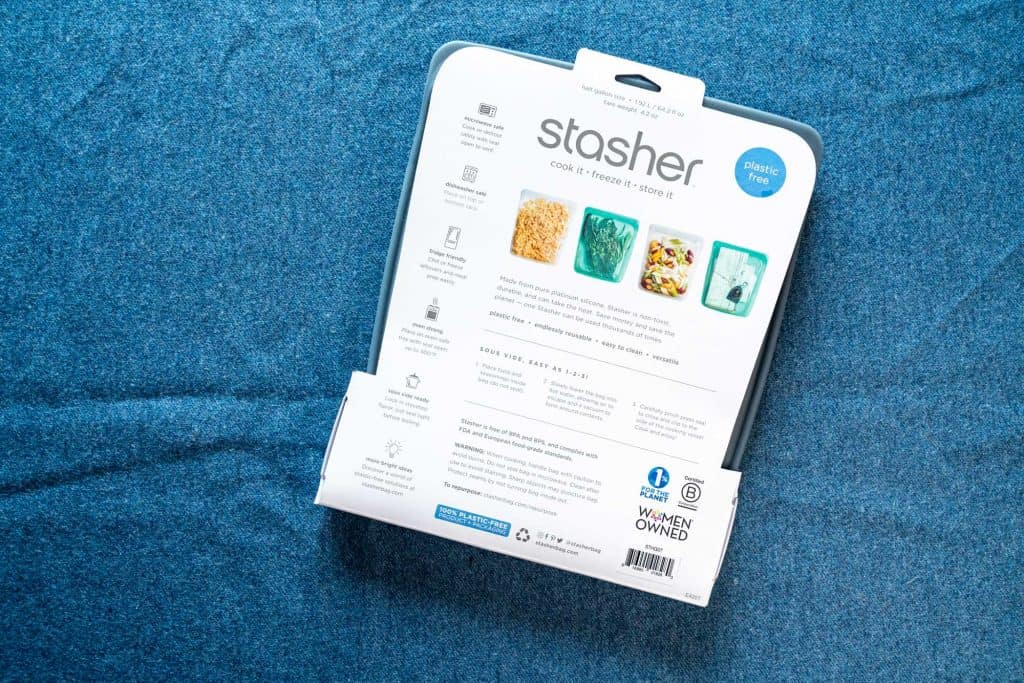
The Packaging Suggests a Problem…
I had heard about some issues that users had with Stasher bags for sous vide cooking, so I was already on the lookout for potential problems. And I quickly found one on the back of the package. There are several sections such as “microwave safe” and “fridge friendly,” each of which tells how to use your Stasher bag in the device mentioned (microwaves and refrigerators/freezers respectively for those two examples).
However, the “sous vide ready” section on the package left something to be desired. The instructions there say: “Lock in stovetop flavor, just seal tight before boiling.”
Huh?
You’ve probably already spotted the problems here, but in case you’re new to sous vide, let me spell them out for you.
- Using the stovetop definitely isn’t a recommended practice for sous vide cooking. It’s technically possible, sure, but it takes a lot of effort and constant attention. Plus a pot on the stovetop doesn’t have water circulation, which is a huge plus for sous vide cooking (and why sous vide sticks are called immersion circulators). Just about anyone serious enough about sous vide to buy bags at this price point will almost certainly own a sous vide machine instead of trying to sous vide on the stove.
- You don’t boil food in sous vide cooking. We could get into a debate about this, sure—maybe you technically could boil food in a bag and argue that it’s sous vide. But realistically, it’s not a thing that’s done (and for good reason; the whole point is to bring food to a precise temperature, not just blast it with heat). In fact, most sous vide cooking is done at 165°F (74°C) or below, well under the 212°F (100°C) boiling point. Typical sous vide cookers don’t even have the option of going up to boiling.
In fairness to Stasher, this is just the packaging. It’s not like they’re actually giving people completely wrong instructions on how to sous vide (unless, of course, someone reads the back of the package and then tries without any further information).
However, this one sentence on the package shows such a fundamental misunderstanding of how sous vide cooking works that it immediately throws up red flags. As soon as I read it, I started doubting whether the bag was designed with sous vide cooking in mind.

Our Tests
I used my Stasher bag several times to see how it would perform under typical sous vide cooking conditions.
I also did two specific tests:
- Cooking messy and intense-smelling food. For this test, I cooked chicken in lots of a yogurt marinade rich with garlic and ginger. The questions I wanted to answer were:
- Is it easy to clean messy food out of the tight corners of the bag? I’ve heard reports of users struggling to clean the deep cracks and crevices, and wanted to deliberately cook something that would make a mess so I could see the cleaning difficulty for myself.
- Does a Stasher bag absorb strong smells? I was concerned that the silicone might hold onto smells, lending a garlicky ginger scent to anything and everything cooked afterward.
- Leaving the bag in a sous vide bath for a long time at a high temperature. We’ve also heard reports of users having issues with their Stasher bags ripping or tearing after regular sous vide use. I decided to try to accelerate any issues by sous vide cooking marbles wrapped in paper towels for 99 hours at 203° F—the longest and hottest settings on my sous vide device.
Read on to learn about the results of these tests, and my thoughts on Stasher bags for sous vide after putting them through their paces.
Test 1: The Mess and Aroma Factor
One of the benefits of not using a suction vacuum sealer bag for sous vide is that you can include a sauce or marinade in the bag. (You can also do this with a chamber vacuum sealer, but sadly, most of us don’t have one of these amazing devices in our home kitchen.)
I tested out this option with the Stasher bag, using chicken in a Bengali-inspired yogurt-based marinade with various spices and flavorings including lots of garlic and ginger.
As mentioned above, there were two questions I wanted to answer with this test. Here’s what I found out:
1. Is the bag easy to clean when its cracks and crevices are full of messy food?
While the cleaning process is easier than I expected, it’s still more challenging than I’d like. The corners, in particular, are tight and deep. Most food came out when I blasted it with tap water from my sink at its highest setting (which is enough to wildly spray water everywhere, and I ended up soaked in the process. Yes, my sink has issues.). A simple rinse, however, didn’t adequately clean out the corners. If you don’t have an insanely strong sink that wildly blasts water out instead of pouring nicely, you may struggle more.
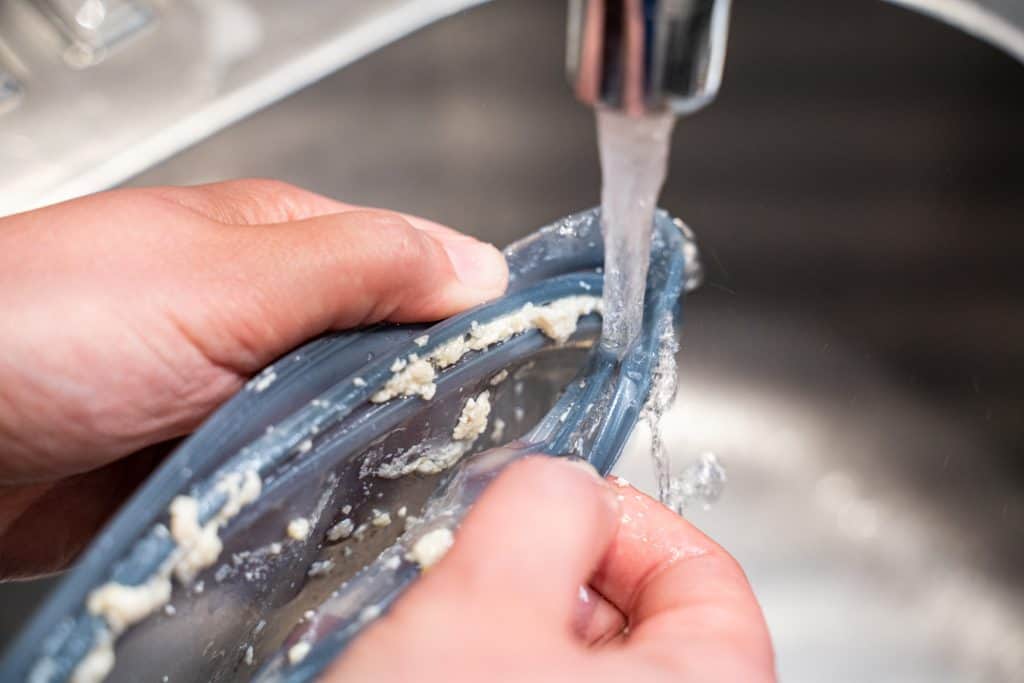
2. Does the silicone bag hold onto the strong odors of fragrant food?
Unfortunately, yes. After thoroughly hand-washing the bag with soap and hot water, I ran it through the dishwasher as recommended. It came out with a distinct garlic and ginger smell, so I ran it through a second time. Even after three washes (one by hand and two in the dishwasher), the bag had a strong aroma.
It’s important to note that this aroma came from just one four-hour cook in the bag, and didn’t require multiple uses to build up. Admittedly I chose strong-smelling aromatics on purpose for the sake of testing this, but I cook with garlic and ginger pretty often anyway.
To be fair, I expected the silicone bag to hold onto the smell, and that’s part of why I ran the test. But unexpectedly, I also found that the Stasher bag doesn’t contain the odor effectively while cooking.
I left for a while partway through the cooking time, and got back to a kitchen that smelled very strongly of cooking garlic and ginger. It was immediately clear that it was coming from the sous vide bath, so the aroma was definitely able to permeate the bag even when it was sealed and underwater. This gave me some doubts about whether the bag was actually airtight and leak-proof, which was soon put to the test…
Test 2: Long, High-Temperature Cooking
Let’s be honest: most sous vide preparations are cooked for just a few hours at a time, and generally not at the highest temperature a sous vide machine allows. However, we’ve heard reports of Stasher bags failing even under this typical use.
To accelerate the process of finding any issues or weaknesses, I cooked marbles wrapped in paper towels in a Stasher bag for 99 hours at 203° F. If normal use can lead to bag failures, I figured this experiment would definitely push the limits and expose flaws or weaknesses.

Why marbles wrapped in paper towels?!
Admittedly, this is a bit of an odd thing to sous vide—but let me explain why this was the choice for the experiment! First and foremost, I didn’t want to waste food on what I saw as a likely doomed experiment from the beginning.
Plus marbles are relatively heavy and dense, so I figured they would hold the bag underwater.
Wrapping the marbles in paper towels gives some insulation to keep them away from the bag directly, but also (and more importantly) makes it very clear if any water leaks into the bag. After all, it’s easy to tell if a paper towel is wet or dry!

Test 2 Results: How Do Stasher Bags Perform Under Long, High-Temperature Cooking?
When I pulled the bag out of the hot water bath four days later, the first thing I noticed was that the paper towels inside were wet. This was immediately obvious, even through the grey bag.
Opening the bag revealed that it was still very firmly sealed, meaning that somehow water had leaked inside during the 4-day, high-temperature sous vide bath despite the bag being properly closed.

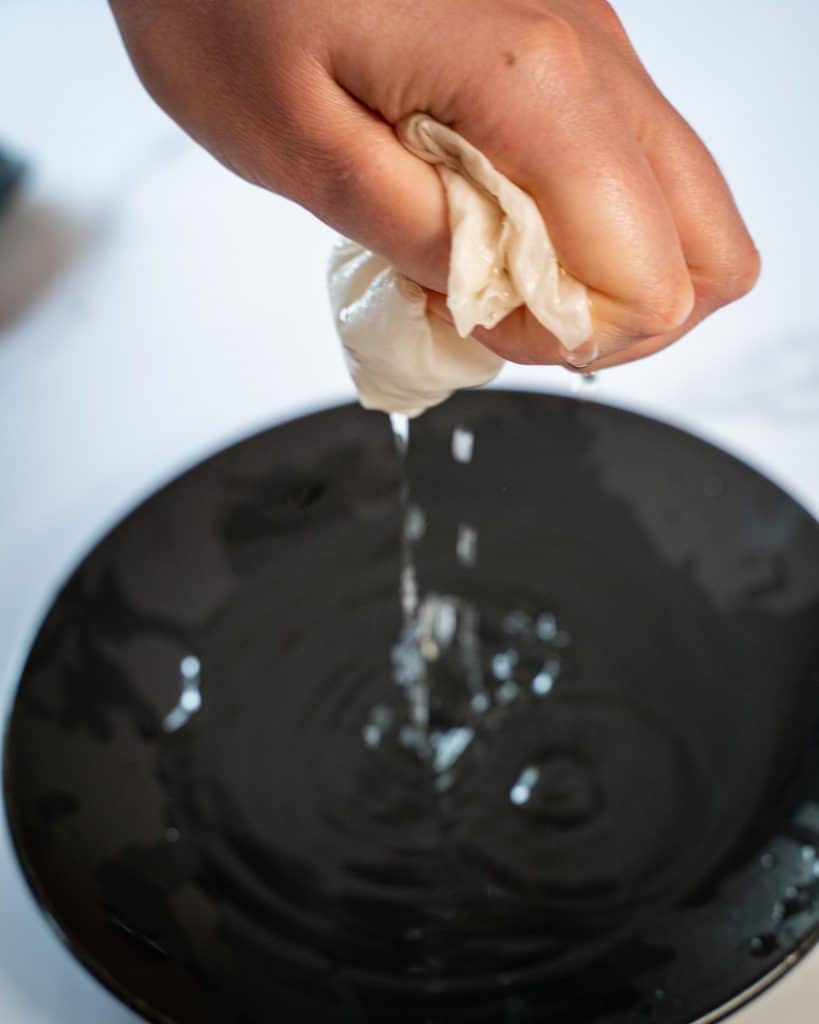
The paper towels were drenched, with approximately 3 tablespoons of water having gotten inside.
This is problematic for two reasons:
- Sous vide cooking is all about precision and control. If you can’t control the amount of water inside your bag (because it somehow gets in during the cooking process), you can’t control the final outcome. A drop or two won’t make much difference in most applications, but three tablespoons is a significant amount of water to unintentionally add to your food.
- Many sous vide containers are not BPA-free. This usually doesn’t bother me because the bag should be a barrier between the container and the food, so if BPA leaches into the water, it still won’t come into contact with the food. Of course, that’s assuming that the BPA-free bag doesn’t leak. Having a bag that lets in significant amounts of water means you’ll need to be much more careful about the container itself.
Other Comments and Considerations
When you’re cooking something in a sous vide bath, it’s vitally important that the food stay underwater at all times. This is partly for food quality, but also partly for health and safety reasons.
From the beginning, I was concerned about this with the Stasher bag. While the silicone is more flexible and soft than I expected, it definitely isn’t supple enough to conform to every curve the way a vacuum sealer bag can. This means that even the water displacement method leaves some air inside the bag.
Even when I used the bag with marbles (which are quite dense and heavy), the remaining air in the bag combined with the buoyancy of the bag itself was enough to make it insist on trying to float.
In short, if you’re going to use a Stasher bag for sous vide, you’ll need some weights. These bags aren’t inclined to stay underwater on their own.
Another side effect of not being able to get all the air out of these bags is that your food can cook unevenly. It’s important to remove almost all air in sous vide cooking, both for quality and even for food safety reasons.
That’s why, even if you have weights, we don’t recommend using Stasher bags for sous vide recipes without a lot of liquid. Having a sauce or marinade in the bag will let you remove more air, because the liquid can fill in those gaps. Anything relatively stiff and dry, though (think of a steak without a sauce) will have air gaps around it, which is problematic.
Are Stasher Bags Leak Proof and Airtight?
For normal storage, possibly. Again, this isn’t what we’re interested in at Cuisine Technology, and so I didn’t test the Stasher bag for this purpose.
For sous vide cooking: no, Stasher bags are definitely not leak proof. Despite thoroughly and carefully sealing the Stasher bag, and triple-checking that it was fully closed, water made its way inside during the test. The paper towels inside, which had been dry at the beginning of the test, were thoroughly wet by the end.
This is obviously a problem; you don’t want the water from your sous vide bath leaking into the bag.
One major issue I have with this is that I don’t concern myself too much with whether sous vide containers are BPA-free, because theoretically the water in the container should never touch your food. If the bag leaks, you’re getting that potentially BPA-contaminated water directly on your food. Yuck. I appreciate that Stasher bags themselves are BPA-free, but does that matter if they let in hot water from a container made of plastic with BPA?
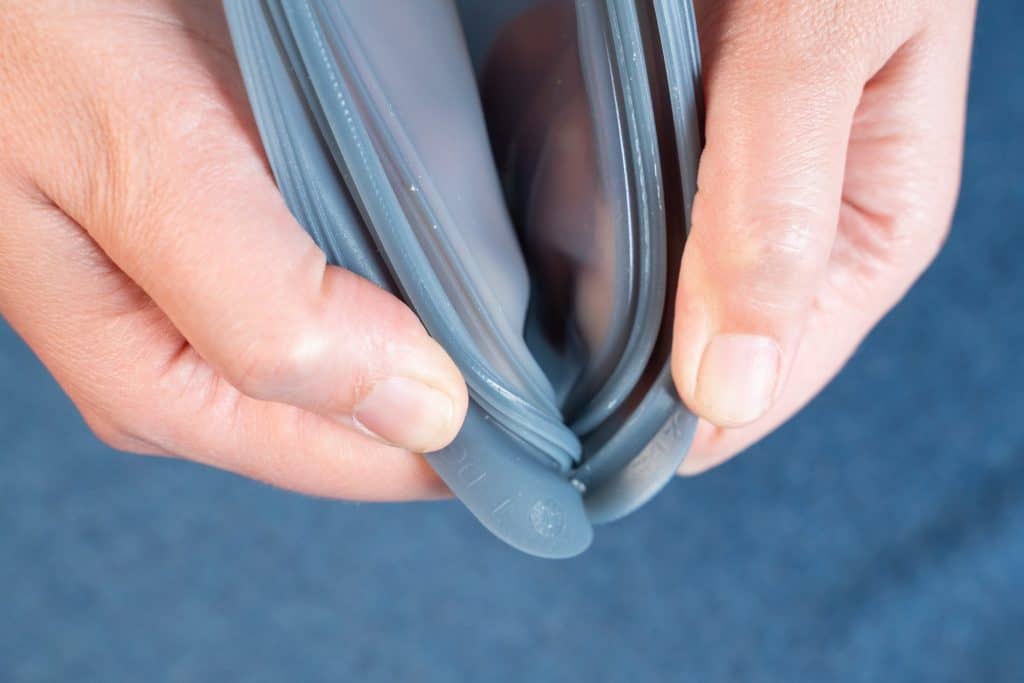
Pros & Cons
Audience
We feel that the ideal audience for Stasher bags is financially comfortable and eco-conscious people who do not plan to use these bags for sous vide or messy, aromatic foods.
If you want some reusable bags to take non-aromatic lunch to work every day, or to store bulk foods in the pantry, these might be great. But they definitely aren’t the ideal solution for sous vide enthusiasts.
You’ll also need to have a decent amount of money to replace your single-use bags with Stasher bags. Like so many things, they’ll save money in the long run, but cost much more upfront.
And while we appreciate the environmentally friendly nature of Stasher bags (by virtue of being plastic-free and reusable so many times), we feel there are better and more affordable options for most of the things these do. I have a couple dozen vintage glass jars that I’ve picked up for $1 or $2 each that work for the kinds of things that Stasher would be good for, like storage of dry non-aromatic bulk goods. Not only are these also reusable, but they’re preowned—so no new resources needed to go into making them.
Pricing – Are Stasher Bags Worth It?
Stasher bags are expensive. That’s taken for granted; they’re reusable, eco-friendly bags with a great marketing team behind them, and they’re priced accordingly. But I would be fine with the price if the bags lived up to the hype.
After all, when you do the math, Stasher bags are very affordable per use. Assuming they actually last for 3000 uses, and given a general price of around $20 for a half-gallon bag, that’s less than a penny per use. Compare this to Ziploc bags at around $0.24 each at the time of writing, and you’ll see that these reusable bags are amazingly affordable over time.
But let’s be realistic. Will you sous vide 3000 times? If you do it twice a week (which is more than the average home cook with a sous vide machine, in our experience), that’s 1500 weeks—or 29 years. As much as I love sous vide, I can’t commit to doing it twice a week for the next three decades of my life. Can you? And given the issues with these bags, we’re not confident that they’ll last for 3000 uses anyway.
If you want the bags for other purposes that won’t be affected by the issues we’ve outlined here, yes, they may be worth it. You would need to use your Stasher bag about 83 times for it to pay for itself compared to Ziploc bags. That’s about four months of use if you pack lunch in it every work day.
And, of course, price isn’t everything—knowing that you’re doing your part to reduce single-use plastic waste is invaluable.
If you intend to use these bags for sous vide, though, I think they’re priced too high given the issues involved.

Final Verdict in Our Stasher Bags Review
While Stasher bags may be great for simple storage (I haven’t tested them in depth for that purpose), I unfortunately don’t recommend them for sous vide cooking. And I hate to say that, because I really, really thought that they were finally the solution I’ve been looking for.
Our smell test quickly demonstrated that Stasher bags absorb odors very quickly, and it’s hard to get rid of them. You may be able to get around this as an issue if you have a designated bag for each type of cooking or strong smell (one for sweet, one for savory, one for ginger, one for garlic…).
Even after one hand wash, two runs through the dishwasher, and a 99-hour cook time with just marbles and paper towels inside, the aroma persisted.
Our durability and leak test showed that, unfortunately, Stasher bags leak during sous vide cooking. By the end of the test, the paper towels that had been dry at the beginning (and gone into a perfectly dry bag) were very wet. This was despite triple-checking that the bag was perfectly sealed before putting it into the sous vide bath. Depending on what sous vide container you use, this may lead to issues with BPA-contaminated water coming into direct contact with your food.
Alternatives for Sous Vide Cooking
For a different reusable silicone option
Platinum Pure Large Reusable Sous Vide Bags. These bags are prone to some of the same concerns as Stasher bags, particularly the tendency to hold onto smells. But their design means that they’re easier to clean and less likely to leak, since the opening never goes underwater.
For home cooks on a budget
Honestly, for the average home cook interested in sous vide, we’re always happy to recommend Ziploc-brand resealable bags. They’re BPA-free and dioxin-free, affordable, easy to find, and come in a variety of sizes.
For anyone with a suction vacuum sealer
FoodSaver 8″ and 11″ Vacuum Seal Rolls Multipack. This set includes a total of five rolls of bags, letting you cut the size you prefer and ensuring you have plenty to last for a while.







